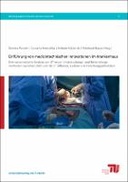Explore

Einführung von medizintechnischen Innovationen im Krankenhaus
0 Ungluers have
Faved this Work
Login to Fave
The use of new examination and treatment methods (NUB) in the inpatient sector remains a contro-versial topic of health policy discussions even after the introduction of an early benefit assessment for certain medical devices of high-risk class. Policy makers must balance access to innovative technologies, risks and benefits of the technologies, and the ability and resilience of the statutory health insur-ance systems to finance those. Weaker approval criteria for medical devices compared to pharmaceu-ticals require consequent evaluation of (clinical) effectiveness and safety when it comes to the diffu-sion of medical devices in standard care. The overall aim of the study is to investigate the importance of scientific evidence for the adoption and diffusion of NUB in German hospitals. Using a new systematic, criteria-based approach, 27 health care relevant NUB have been identified for further analyses. For these, the development of evidence regarding efficacy and safety as well as the development of the case numbers in hospitals was ana-lyzed longitudinally (2005–2017). Publications were systematically identified, selected, and evaluated to create an overview of evidence available at different point of times. Other factors such as changes in financing schemes and safety alerts have been considered in the analysis. In addition, the utilization and research activities of German hospitals have been identified and analyzed descriptively. A relationship between diffusion and evidence development can be assumed for about half of the included methods. For the remaining methods, either the body of evidence is too sparse, the case numbers are too small to infer a relationship, or the case number and evidence development show opposite directions. In the sample, it takes up to ten years after marketing authorization until the first results of a randomized clinical trial are published. A robust body of evidence is only available for the majority of technologies after several years of use or does not emerge at all during the observation period. With regard to financing schemes, the study confirms that temporary payments for NUB have been paid for several years without evidence of benefit of the corresponding technologies. The need to submit annual NUB applications for funding does not appear to be a barrier to rapid diffusion. Despite various differences between technologies, case numbers in hospitals participating in studies (usually large hospitals or university hospitals) were generally higher compared to the remaining hos-pitals; in particular in the first years of NUB utilization. At the same time, however, some hospitals use new methods based on high-risk medicines infrequently, which in turn raise questions about patient safety and quality of care in these hospitals. Overall, the trade-off between promoting innovation and ensuring evidence-based care remains a fundamental challenge. Considering all methodological limitations, the results support the impetus to question the existing regulatory framework for NUB and to focus on systematic evidence generation. It is essential to find a common solution that focuses on the efficacy/effectiveness and safety of the technologies for patients, but also provides a framework for systematic evidence generation.
This book is included in DOAB.
Why read this book? Have your say.
You must be logged in to comment.
Rights Information
Are you the author or publisher of this work? If so, you can claim it as yours by registering as an Unglue.it rights holder.Downloads
This work has been downloaded 44 times via unglue.it ebook links.
- 44 - pdf (CC BY) at Unglue.it.
Keywords
- benefit assessment
- evidenced based medicine
- health technologies
- inpatient care
- medicine
- Medicine: General Issues
- Public health & preventive medicine
- Régulation
- thema EDItEUR::M Medicine and Nursing::MB Medicine: general issues::MBN Public health and preventive medicine
Links
DOI: 10.14279/depositonce-15412Editions

